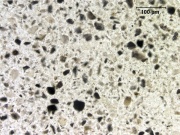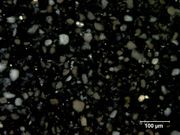Difference between revisions of "Bone, calcined"
Jump to navigation
Jump to search
(username removed) |
|||
| Line 1: | Line 1: | ||
| − | [[File:2_Calcined_bone_200X.jpg|thumb|Calcined bone]] | + | [[File:2_Calcined_bone_200X.jpg|thumb|Calcined bone at 200x]] |
== Description == | == Description == | ||
| + | [[File:2_Calcined_bone_200X_pol.jpg|thumb|Calcined bone at 200x polarized light]] | ||
| + | Bone consists of an organic framework of [[collagen]] along with crystals of [[apatite]]. With age, hydroxyapatite (calcium phosphate) is slowly replaced by calcium carbonate. When bone is burned, it goes through a series of stages that begin with discoloration and denaturing of the collagen, followed by charring, total combustion of the organic fraction followed by combustion/recrystallization of the inorganic portions. All organic carbon has burned away by around 600°C, at which point bone color has shifted from gray to light bluish-gray. By 650°C the bone has become pure white. This is the calcined state. | ||
| − | + | == Synonyms and Related Terms == | |
| + | bone ash, bone black | ||
| − | == | + | ==Physical and Chemical Properties== |
| − | + | Calcined bone is resistant to acid dissolution | |
| − | |||
| − | |||
| − | |||
| + | ==Resources and Citations== | ||
| + | * J. Chatters, J. Brown,S. Hackenberger, P. McCutcheon, & J. Adler (2017). CALCINED BONE AS A RELIABLE MEDIUM FOR RADIOCARBON DATING: A TEST USING PAIRED NORTH AMERICAN SAMPLES. ''American Antiquity'', 82(3), 593-608. (2017). [https://www.cambridge.org/core/journals/american-antiquity/article/calcined-bone-as-a-reliable-medium-for-radiocarbon-dating-a-test-using-paired-north-american-samples/3B51E2C47845621D81B124042AB2A1DE link] | ||
[[Category:Materials database]] | [[Category:Materials database]] | ||
Latest revision as of 15:30, 9 May 2022
Description
Bone consists of an organic framework of Collagen along with crystals of Apatite. With age, hydroxyapatite (calcium phosphate) is slowly replaced by calcium carbonate. When bone is burned, it goes through a series of stages that begin with discoloration and denaturing of the collagen, followed by charring, total combustion of the organic fraction followed by combustion/recrystallization of the inorganic portions. All organic carbon has burned away by around 600°C, at which point bone color has shifted from gray to light bluish-gray. By 650°C the bone has become pure white. This is the calcined state.
Synonyms and Related Terms
bone ash, bone black
Physical and Chemical Properties
Calcined bone is resistant to acid dissolution
Resources and Citations
- J. Chatters, J. Brown,S. Hackenberger, P. McCutcheon, & J. Adler (2017). CALCINED BONE AS A RELIABLE MEDIUM FOR RADIOCARBON DATING: A TEST USING PAIRED NORTH AMERICAN SAMPLES. American Antiquity, 82(3), 593-608. (2017). link

